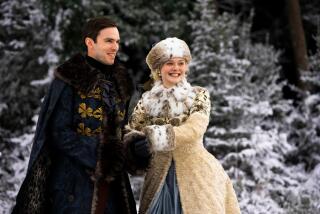A Day With Catherine the Great
- Share via
Last weekend more than evened the score with my young friend Martin Erck.
He has now repaid me for those afternoons at my house in Fullerton 30 years ago, blowing uncertain trumpet with some fellow seventh-graders. They called themselves the Dukes of Dixieland, and the repertoire of the Dukes was a little harsh for Martin’s attorney father after a day in court, so they couldn’t practice at home.
In addition to bringing the music of the Dukes, Martin would be accompanied by Pidge, his family’s dog. Pidge used to fly through our house, too busy to say hello, but with just time to grab a roast--and one time a Swiss steak waiting on the oven door to be put inside.
Last weekend Martin made up for it all and showed his customary flash of class by taking his mother, my friend Jean Erck, and me to the Catherine the Great exhibit at the Armand Hammer Museum of Art and Culture Center in Westwood, which I had never visited before.
The brochure describing the exhibit is full of flourishes and folderol but does not begin to describe the Russian court during the reign of the theatrical Catherine II. What the art and jewel exhibit shows is that the history of Russia is full of passion and glory and gold leaf.
None of the opulent history of the country has equaled the reign of Catherine the Great, the German princess who became the Russian empress in the late 18th Century. She was brought to the Russian court to marry Peter III. But the German princess was a poor choice of wife for the hapless Peter. After he ascended the throne, Catherine’s military men murdered him.
The amply rounded Catherine became empress of Russia and the most “Russian” monarch the country had ever seen. She practiced cultural exchange and artistic development. She determined that Russia should be the treasure house of the greatest art works in the world.
She was the most liberal ruler of her time, and wrote a number of books. She allied herself with the Enlightenment and corresponded with Voltaire and Diderot. She bought the libraries of both men and brought them to St. Petersburg.
The exhibit at the Hammer includes belongings and clothing of the empress and her grandsons and lovers. She had dozens of lovers and each of them received an opulent bauble when he was replaced by the inevitable next. There are porcelain, China and an 18-inch chalice the colors of new leaves and transparent shallow water.
As Catherine grew older, she chose younger lovers and rewarded them with luxurious jewels and snuff boxes--the empress herself sniffed a pinch of snuff now and then. She also clothed her grandsons in magnificence. There is one suit on exhibit of salmon-colored silk velvet embroidered in silver.
The most breathtaking thing on display is Catherine’s coronation coach. It was first ordered by Peter the Great from the Gobelin factory in France for the coronation of his wife Catherine I and built by the finest artists and craftsmen in the court of Louis IX. The side panels were painted with allegorical scenes by the French master Francois Boucher. The wheels are six feet tall.
The last czar, Nicholas II, had miniatures made of Catherine’s coronation regalia--the onion-shaped crown, the orb and the scepter. They were made by Faberge masters and are decorated with 4,400 uncut diamonds and 1,300 brilliants. The famous Orlov diamond in Catherine’s scepter was Gregory Orlov’s farewell gift to his mistress after a 10-year love affair. To represent it in the miniature, the court jeweler used a faceted diamond called the Indian Rose.
All of these treasures have been brought to the Hammer Museum from the Hermitage in St. Petersburg.
Late that afternoon, Martin went home to his Santa Monica condo, and Jean and I went back to La Quinta. The desert was ringed with a blue sky just the color of the emblem on one of Catherine the Great’s favorite goblets.
More to Read
The biggest entertainment stories
Get our big stories about Hollywood, film, television, music, arts, culture and more right in your inbox as soon as they publish.
You may occasionally receive promotional content from the Los Angeles Times.









